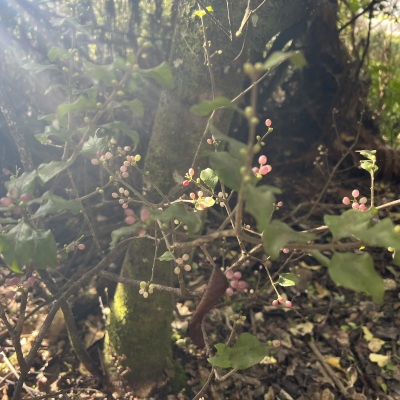
23 August 2024
It’s not widely known that New Zealand has its own rare native mistletoe, but this hard-working volunteer care group have a mission to turn that around. The Ōkāreka Mistletoe Restoration Project/Tikitapu Scenic Reserve Pest Control Project, established in 2002, aims to increase the population of two native threatened semi-parasitic mistletoe species in the Tikitapu Scenic Reserve, Rotorua. The project concentrates on pest and weed control to provide a conducive environment for the mistletoes to thrive.
Mistletoes are an important part of our native forest ecosystem. It is also a food source for our native birds and insects. Mistletoe is a taonga species which can be a good indicator of a healthy forest. There is a well-known correlation between possum control and healthy mistletoe.
The Mistletoe Restoration Project is co-led by volunteers Margaret Dick and Mike Goodwin, with support from Bay of Plenty Regional Council, Department of Conservation (DOC), Forest & Bird, Rotorua Botantical Society and Landcare Ōkāreka. As well as support and engagement of the mana whenua and local agencies such as Tūhourangi Tribal Authority and the Rotokakahi Board of Control.
It’s this shared commitment to a common goal which has achieved so much for mistletoe and the health of the Ōkāreka ngahere.
Pictured: Project Co-Lead Mike Goodwin & Dale Williams from Bay of Plenty Regional Council brief the volunteers for the work ahead
There are nine species of mistletoe within Aotearoa and two of these are found growing within the Ōkāreka reserve. They are:
In 2001 DOC completed a survey at Ōkāreka before pest control started which showed an estimated mistletoe population of 218 mistletoe plants. Another census was completed in August 2016 which revealed a total of 2034 mistletoe plants present at the Ōkāreka end of the reserve, an almost 10-fold increase in plant numbers. A survey completed in January this year show a total of 8044 plants as well as the area that plants inhabit has also extended. The results from this survey showed how the mistletoe population had increased in abundance and distribution in the last 15 years as a direct result of ongoing intensive pest control.
White mistletoe, Tupeia antarctica, which has a threat ranking of ‘At Risk – Declining’ has increased through the lifetime of the Ōkāreka project from 218 to 8044 live plants in 2024 within this reserve. Regionally threatened green mistletoe, Ileostylus micranthus, has naturally colonised the reserve and now numbers at 55 plants, up from zero.
Mistletoe abundance has increased more than 3600% over 22 years in Tikitapu Scenic Reserve at Lake Ōkāreka thanks to the efforts of volunteers and staff across multiple organisations.
As a result of the ongoing pest control (plant and animal) this is now by far the largest known Tupeia population in the Rotorua District and wider Bay of Plenty. Both mistletoe species are now present in greater abundance and distribution than previously known which is a fantastic result.
One of the known factors which increases the health and growth of mistletoes is sustained and regular pest animal control, in particular possums. This is a site where there has been consistent pest animal control which is due to the diligence and hard work of the volunteers from Forest and Bird assisted by Landcare Ōkāreka and pest plant control by volunteers from Rotorua Botanical Society and Landcare Ōkāreka. Pest plant control reduces competition from pest plants which in this area is an additional significant threat to mistletoe and host plants.
Bay of Plenty Regional Council Biosecurity Officer, Dale Williams notes that Council is proud to have supported this project with pest control advice, funding, and resources.
See this rare native plant for yourself by walking the DOC track located opposite the fire station in Ōkāreka – see the link below for more information on this great walk.
Pictured: Sign at entrance to the mistletoe walk at Lake Ōkāreka
Pictured: Native mistletoe with the white berries showing in the winter